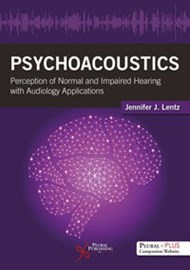The field of psychoacoustics and the practice of audiology have always been curious bedfellows. In the clinic, we commonly assess patients’ hearing ability through pure-tone detection, a classic psychoacoustical phenomenon, but just one of the many, many ways in which we hear sound. Knowledge of the breadth of psychoacoustics, and the myriad of psychoacoustical phenomena that can be affected by hearing dysfunction, is paramount to good clinical practice.
Gathering the appropriate knowledge from the current literature is possible but requires culling and filtering multiple sources suited for other practices (e.g. audio engineering). Enter into this fray another eponymous tome on psychoacoustics by Prof Jennifer Lentz with a slight twist: it was specifically written with the audiologist in mind.
As it intends, the book would indeed serve as an excellent text for a course within a university audiology programme or as an extended segment in a broader course. The chapters make handy modules, and the format is something of an instant syllabus – just add students! The end-of-chapter questions are extensive; to answer all of them requires both an understanding and application of the knowledge introduced. The format takes those within audiological circles from the familiar and concrete – the measuring of thresholds in quiet – through to the more foreign and ambiguous – the manifold perceptions of pitch and phenomena of binaural hearing. The last chapter on audiological implications is the shortest, but this is more of a summary of the implications highlighted in each chapter. One striking omission is speech processing, but that is a briar-patch-of-a-field unto itself and could do with a course and textbook of its own (e.g. Rosen & Howell’s Signals and Systems for Speech and Hearing).
Stylistically, the textboxes are a bit confusing as to their relevance, and there is little physical space for marginalia. The writing is dense at times, but there are very little assumptions of a prior knowledge in physiology, psychology or maths. Lentz gives ample mention of the “giant shoulders” upon which our current body of knowledge stands, allowing any student wishing to dig deeper to seek out the primary sources for inspiration. And there are supplementary online materials – seven demonstrations and five experiments – to better grasp the concepts discussed.
Overall, it’s an excellent way to make psychoacoustics a more welcome neighbour in our clinics.




